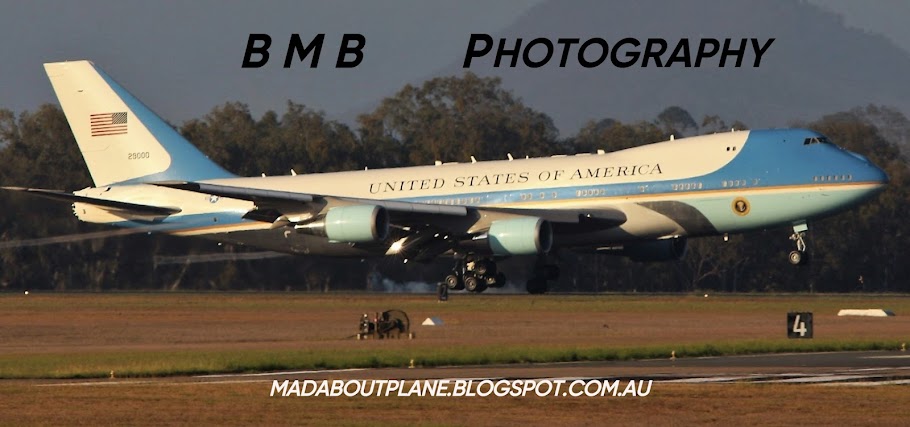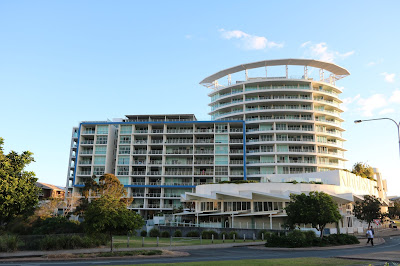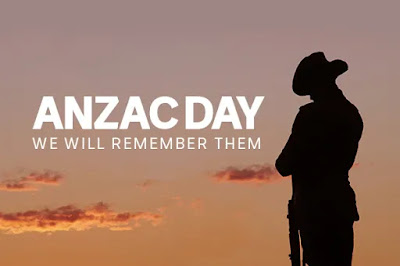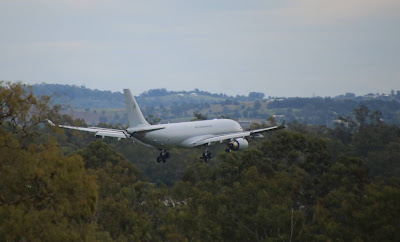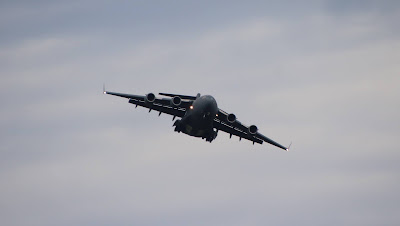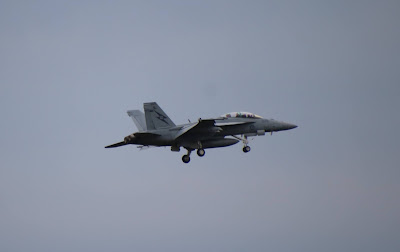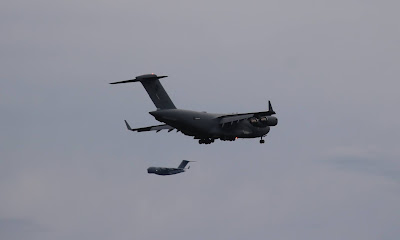 |
| VIRGIN ATLANTIC A340-642 G-VFIT (MSN 753) |
Friday 30 April 2021
Virgin Atlantic passenger spared jail for attack at 40,000ft
Wednesday 28 April 2021
Spotting at Coolangatta (OOL/YBCG)
On holidays from work for a week my wife and I headed down to the Gold Coast to stay for three nights. Gold Coast airport is only 5 km's from our hotel and knowing Alliance Airlines were bringing in their Embraer E190 from Townsville we ventured out for an hour or so to see this come in. This is the first time I have seen this in the air, as most of the time its on the ground in Brisbane. It was also great to see Air New Zealand arrive on the Gold Coast.
 |
| SURFERS PARADISE |
 |
| VIEW FROM OUR BALCONY |
 |
| AIR GOLD COAST CESSNA 172R VH-NWZ (MSN 172-80933) |
 |
| ALLIANCE AIRLINES E190AR VH-UYW (MSN 19000174) TL180 ARRIVING FROM TOWNSVILLE |
 |
| TL 181 HEADING BACK TO TOWNSVILLE |
 |
| JETSTAR A320-232 VH-VQH (MSN 2766) JQ411 OFF TO SYDNEY |
 |
| REX (REGIONAL EXPRESS) B737-8FE VH-RQC (MSN 33797) ZL520 ARRIVING FROM SYDNEY |
 |
| CESSNA 441 VH-TAZ (MSN 441-0005) OFF TO HOBART |
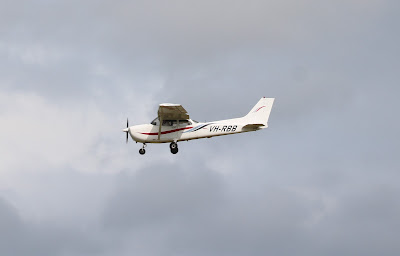 |
| AIR GOLD COAST CESSNA 172R VH-RBB (MSN 172-80776) |
 |
| AIR NEW ZEALAND A321-271NX ZK-NNB (MSN 08542) NZ187 ARRIVING FROM AUCKLAND |
 |
 |
| PIPER PA-32R-301 VH-LTC (MSN 32R-8113047) |
 |
| REX (REGIONAL EXPRESS) B737-8FE VH-RQG (MSN 34168) ZL658 ARRIVING FROM MELBOURNE |
 |
| CESSNA 172N VH-BGN (MSN 172N-70356) |
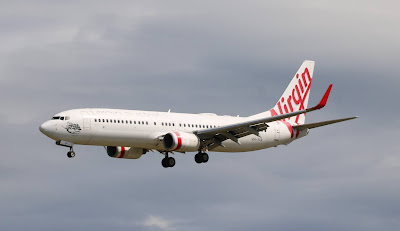 |
| VIRGIN AUSTRALIA B737-8FE VH-YIA (MSN 37824) VA511 ARRIVING FROM SYDNEY |
 |
| PILATUS PC-12/47E VH-PLE (MSN 1607) |
 |
| TVPX AIRCRAFT SOLUTIONS BOMBARDIER CL-600N360SL (MSN 5456) |
 |
| MWP RACING BOMBARDIER CL-600-2A12 VH-MXK (MSN 3003) |
Tuesday 27 April 2021
The Story Of Air Force One – The Flying Whitehouse
The start of Presidential travel
Franklin Roosevelt was the first US President to fly whilst in office. He flew on a Pan American Airways-crewed Boeing 314 Clipper flying boat to attend the Casablanca conference in 1943. President Theodore Roosevelt had become the first President ever to fly more than 30 years before that, when he took to the air in a Wright Flyer aircraft. However, this was a leisure flight during a county fair at Kinloch Field, and he had left office by that time.
The idea of a dedicated presidential aircraft soon followed, with a modified C-87 Liberator Express aircraft, named ‘Guess Where II,’ operating from 1943 to 1945. It was not deemed safe enough for the President himself, however.
The first aircraft to be approved was a modified Douglas C-54 Skymaster, in 1945. This was officially named ‘The Flying Whitehouse’ but soon earned a more popular nickname of ‘Sacred Cow’ due to its security. It carried Presidents Roosevelt and Truman and remained in service until 1961.
It was joined in 1947 by a C-118 Liftmaster (a military-modified Douglas DC-6 aircraft), known as ‘Independence.’ This introduced some of the fittings that presidential aircraft have become known for, with a separate stateroom onboard as well as seating for 24 passengers.
The first ‘Air Force One’
The real story of Air Force One starts a bit later. Dedicated aircraft were in use from 1945, but a dedicated callsign was not used until 1953. President Eisenhower introduced several large propeller aircraft. The first of these was a Lockheed Constellation aircraft, named ‘Columbine II.’ In January 1953, the use of the callsign ‘Air Force One’ was introduced for this aircraft. This happened following an incident where ‘Air Force 8610’ carrying the President was confused with commercial flight ‘Eastern Air Lines 8610.’
Columbine II was replaced by Columbine III, a Lockheed Super Constellation aircraft, in 1953. Columbine II still retains a special place in US aviation history. It was restored and flew again as part of President Eisenhower’s 100th birthday celebrations in 1989.
Air Force One jets – the 707s
Air Force One entered the jet age in 1959 and started a relationship with Boeing that continues today. Again, it was President Eisenhower who approved and oversaw the introduction of the first jet, a modified Boeing 707 (this was a C-137 Stratoliner, modified as VC-137).
Over the next 30 years, three 707s were introduced. These carried the designation of Special Air Mission (SAM) and were the callsigns used when not serving as Air Force One. This continues with the 747s today.
- SAM 970 was the first 707, introduced in 1959. It was the main aircraft for President Eisenhower and also carried Presidents Kennedy, Johnson, and Nixon.
- SAM 2600, a modified Boeing 707-353B, was the next upgrade, introduced in October 1962, under President Kennedy. It served as the main transport for Presidents Kennedy, Johnson, and Nixon. It introduced a private suite area for the President and his family (after a refit under Nixon). This, of course, remains a feature today.
- SAM 27000 was the final 707, introduced in 1972. It remained in service until 2001 (long after introducing the 747s) and served seven presidents – Nixon, Ford, Carter, Reagan, George H Bush, Bill Clinton, and George W Bush. It was the first ‘Air Force One’ to be fitted with missile defense systems.
Preserving the jets
All three 707s have been preserved. SAM 970 is on display at the Museum of Flight in Seattle. SAM 26000 is on display at the US Air Force museum in Ohio. And SAM 27000 is displayed at the Ronald Reagan Presidential Library and Museum in California.
This is a tradition that is likely to be maintained with at least one of the current 747s. The George and Barbara Bush Foundation has expressed interest in taking one after retirement, potentially displaying it in his library and museum in Texas.
The Air Force One livery
The 707s introduced another aspect of Air Force One – its distinctive livery. This iconic blue, white, and gold color scheme was introduced for the second 707, under President Kennedy. French-American designer Raymond Loewy designed it. He is credited with several other classic designs, including TWA’s logo, the Greyhound logo, and work with several railroads. This livery was retained for the VC-25A aircraft, but there is some controversy over what will be used for the upcoming replacements. President Trump proposed a new livery, with a patriotic red, white and blue color scheme. Demonstrating the keen interest in this, Biden’s new administration was asked about it on the day the new President was sworn in, with White House Press Secretary Jen Psaki replying:
Today’s modified 747-200s – VC-25A
The 707s were replaced by a pair of 747s in 1990. These are officially named SAM 28000 and SAM 29000 and are heavily modified 747-200 aircraft, with Boeing designator VC-25A.
President Reagan ordered the new aircraft, but (mainly due to delays with interior wiring) they were not delivered until President Bush was in office.
Inside the 747s
Air Force One interiors and facilities have become more advanced and lavish over time. Larger propeller aircraft allowed staterooms and separated seating, and the 707s took this further with office space and later a private residence. But the extra space offered by the 747 has allowed much more.
Simple Flying took a fascinating look through the VC-25A in detail. First Lady Nancy Reagan designed the interiors, apparently to recall her native US Southwest home. The upper deck is for crew and houses communications and defense systems. The President’s apartment and office are at the front of the main deck, with a medical suite, conference room, and several offices behind that. Separate cabins for invited guests and the media follow, with the general protocol being that passengers can move aft of their seat location, but not forward.
Coming soon – new 747-8 aircraft
The 747-200s have given over 30 years of service, but like many other 747s worldwide, their time is coming to an end. In 2016, the US Air Force confirmed a contract with Boeing for two 747-8I aircraft. These will carry the designator VC-25B and are due to enter service by 2024.
Interestingly, there had been initial interest in the Airbus A380. In the end, Airbus pulled out, as it believed it would not make financial sense to move production to the US for just two aircraft. The Boeing 787 was considered as well.
The Story Of Air Force One - The Flying White House - Simple Flying
Monday 26 April 2021
Happy Birthday Air New Zealand
Air New Zealand's story began on the 26th April 1940 when its forerunner airline, Tasman Empire Airways Limited (TEAL) was incorporated. Founded on the 26th April 1940, it started operations four days later, on the 30th April. Its first flight, flown with a Short S30 flying boat, connecting Auckland and Sydney. TEAL began its first trans-Tasman services with flying boats, and over the years steadily expanded the size and scope of its operations and the extent of its international network. The route network was expanded from Australia and the Pacific to Asia, the USA, the UK and Europe. In October 1953 TEAL became jointly owned by the New Zealand and Australian Governments, and in April 1961 the New Zealand Government assumed full ownership.
 |
Their first 747-200 arrived on the 22nd May 1981 (ZK-NZV CN 22722) and their last Boeing 747-400, affectionately referred to by pilots as "Daddy's Yacht", completed its final flight on the 12th September 2014 landing in Auckland from San Francisco. ZK-NBV (CN 26910) was that aircraft.
 |
| AIR NEW ZEALAND B787-9 ZK-NZE (MSN 34334) |
 |
| AIR NEW ZEALAND A320-271 ZK-NHA (MSN 8715) |
 |
| AIR NEW ZEALAND A321-271 ZK-NNA (MSN 8496) |
 |
| AIR NEW ZEALAND A321-271 ZK-NNC (MSN 8573) |
Air New Zealand's mainline fleet consists of Boeing aircraft for long-haul flights, and Airbus aircraft for domestic- and short-haul international flights. Its wholly owned subsidies, Mount Cook Airline, Eagle Air and Air Nelson, operate ATR 72 and Bombardier Q300 turboprop aircraft. Air New Zealand had wholly owned subsidiary regional airlines and together they made up Air New Zealand Link. On the 26th August 2016 Eagle Airways ceased operations, and in late 2019 Air Nelson and Mount Cook Airline were merged into its parent's operations.
 |
| AIR NEW ZEALAND DASH 8 Q311 ZK-NEA (MSN 611) |
 |
Airbus A320 Neo 4
Airbus A320-200 21
Airbus A321 7
Airbus A321 Neo 7

ATR 42/72 28
ATR 72 28
Boeing 777 3
Boeing 777-300 3* Stored

Boeing 787 14
Boeing 787-9 14
Dash 8 23
Dash 8-300 22
The airline is a Star Alliance member has been a member since 1999.
Sunday 25 April 2021
ANZAC DAY 2021
They shall grow not old, as we that are left grow old:
Age shall not weary them, nor the years condemn.
At the going down of the sun and in the morning,
We will remember them.
LEST WE FORGET
The First World War remains the costliest conflict in terms of deaths and casualties. From a population of fewer than five million, 416,809 men enlisted, of whom more than 60,000 were killed and 156,000 wounded, gassed, or taken prisoner.
The Red Poppy
In Flanders fields
The red or Flanders poppy has been linked with battlefield deaths since the Great War (1914–18). It was one of the first plants to grow and bloom on battlefields in the Belgian region of Flanders. The connection was made most famously by a Canadian medical officer, Lieutenant-Colonel John McCrae, in his poem, ‘In Flanders fields’.
LEST WE FORGET
Saturday 24 April 2021
An hour at Amberley Airforce Base
 |
| RAAF AIRBUS A330-203 MRTT A39-003 (MSN 969) |
 |
| RAAF BOEING C-17A |
 |
| RAAF BOEING C-17A A41-210 (MSN 50240) |
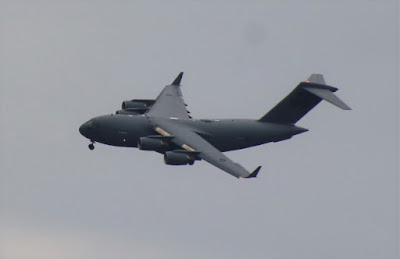 |
| RAAF BOEING C-17A A41-212 (MSN 50271) |
 |
| RAAF BOEING F/A-18F SUPER HORNETS |
 |
| RAAF BOEING F/A-18F SUPER HORNETS A44-221 (MSN AF-21) |
 |
| RAAF BOEING F/A-18F SUPER HORNET A44-219 (MSN AF-19) |
 |
| RAAF BOEING F/A-18F SUPER HORNET A44-209 (MSN AF-9) |
 |
| RAAF AIRBUS A330-203 MRTT A39-005 (MSN 1183) |
